The Island Paradise: Philippines
Insights on my experience through the Philippines!
Dear Readers,
This blog post took some time to write. I’ve tried to focus solely on the essentials because I often got lost in the small details, which would have doubled the reading time.
I spent 22 days in a breathtaking island paradise, experiencing so much and learning a lot about Filipino culture. Like every good story, this one begins at the start. After a 4-day stay in Singapore, I flew onward to the Philippines. The flight itself took just four hours until I arrived at Manila Airport (MNL), the capital's gateway. Even before my arrival, I had to register as a tourist via the eGov app. The process took no more than ten minutes and was completely free. With German citizenship, you receive a visa on arrival at no cost, valid for 30 days.
And so, I found myself on another flight, this time even further east. As I approached the country, I was greeted by countless small islands and turquoise waters. After landing at the airport, I grabbed my luggage and informed my acquaintance that I had arrived. I made my way through the crowds to the pick-up station. There are many ways to get from point A to point B here, such as taxis, shuttles, tricycles, buses, jeepneys, and my personal favorite: Grab. But why should you use Grab? The Grab app is essentially the Asian version of Uber, allowing you to book taxis at fixed prices and even order food. Especially when you’re new to a foreign country, it’s a good idea to play it safe at first and get familiar with the local prices. Luckily for me, I didn’t have to request a Grab ride, as my acquaintance had kindly made the effort to pick me up.
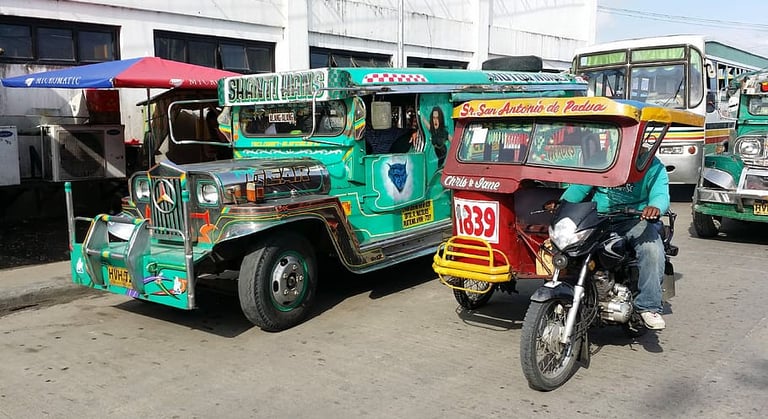

Jeepneys (left): The brightly painted "party buses" of the Philippines – born from old U.S. military jeeps, now the cheapest and most chaotic taxis for many passengers on fixed routes. Hop on, pay a small fare, and hold on tight!
Tricycles (right): Motorcycles with sidecars that look like they scored a sidecar at a flea market. Perfect for short distances, available on the spot – like a Filipino Uber, just a bit shakier!
At the pick-up station, I saw my friend waving at me from afar. She would be my companion for many adventures during this journey. I was greeted with overwhelming hospitality and a giant bag of sweets. If you didn’t know already: Filipinos love sugar and can hardly imagine life without it. Whether in coffee or pastries, sugar is everywhere.
We got into the car and drove to Santa Rosa, a small town about two hours from Manila. Along the way, we talked about all kinds of topics – from our long-standing friendship to our travel plans. After an hour, we stopped at a local restaurant to grab a bite to eat.
On the menu: Filipino cuisine. If you’ve ever been to the Philippines, you probably already know what I’m about to say. The food is pretty repetitive – it’s mostly rice, pork, or chicken. It’s filling but definitely not for foodies who crave variety. I ordered a drink and was immediately peppered with curious questions by the waiter, as tourists seemed to be a rarity here (at least in this town). This wouldn’t be the last time I felt like a celebrity. After the quick stop at the restaurant, we continued on to Santa Rosa, where I had already booked an Airbnb for the next three days. Airbnb options here are plentiful and of a good standard. Prices during the season I traveled ranged from €20 to €30 per night. Once we arrived, I was already pretty tired and checked into my room. Unfortunately, there was no Wi-Fi on the first night due to a technical issue. But that wasn’t a big deal since I was already exhausted from the journey so far.
The next day, I had arranged to meet my friend at Bookee’s Cafe to plan the upcoming weeks. The cafe was only a ten-minute walk from my room. “No problem, I’ll just walk,” I thought and headed out. But I had underestimated the significantly different climate compared to Singapore. While Singapore occasionally offers breezes and building shadows for relief, the Philippines lacked such comforts. And bear in mind, October here usually only brings overcast skies. I can’t even imagine how it must feel in the summer. Worn out from the surprisingly short walk, I arrived at the cafe and ordered an Americano. My friend was already waiting for me, as today we wanted to plan the course of our trip.
We came up with many ideas for which islands to visit. It wasn’t easy to settle on specific destinations, as the 7,000 islands make choosing quite the challenge. So, we compared flight prices and researched activities for the next two days. During this time, I was introduced to a new, large group that immediately welcomed me into their clique. Like most Filipinos, my new friends were very kind and inviting. We talked not only about travel and culture but also about perhaps the most exciting topic in any country: language. We taught each other insults and everyday phrases. My favorite word: Bobo ka!
Filipinos primarily speak Tagalog but are also proficient in English. In most regions of the country, speaking English shouldn’t be a problem. I quickly grew fond of the group – and they clearly felt the same about me. From scooter rides to card game sessions, we shared a lot of great moments. But this wouldn’t be the last time I’d see my new friends.
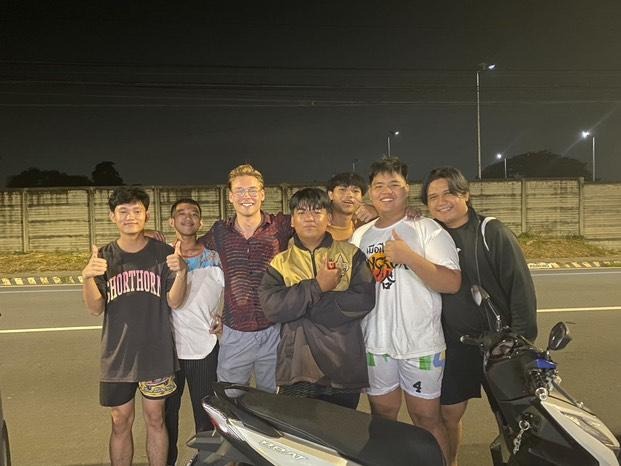
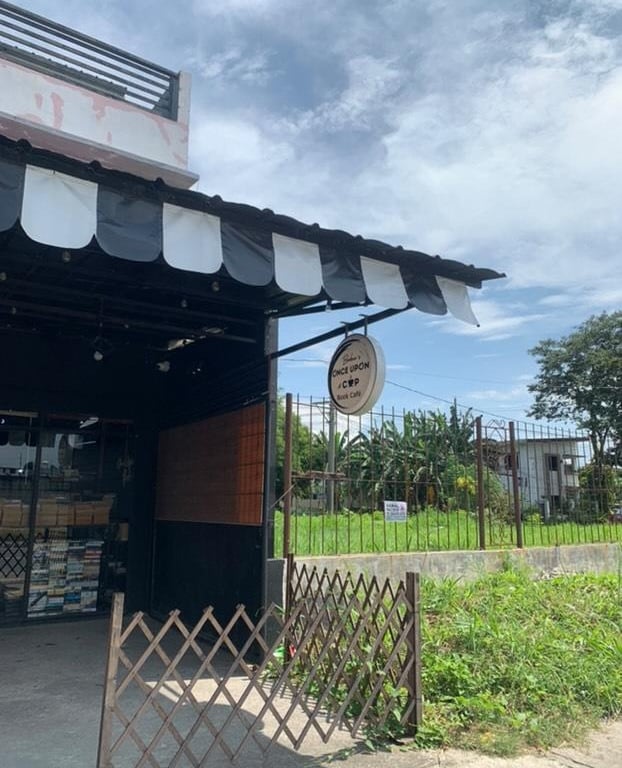
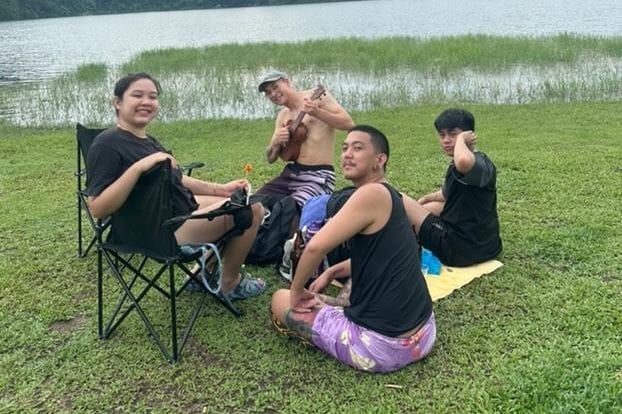

On the second day of my trip, we headed to a lake about two hours away from Santa Rosa. Friends of my friends had invited me to join them. Yes, it all sounds a bit confusing, but in this culture, people are so much more relaxed and spontaneous, making it easy for me to meet new people. After a two-hour drive, we settled by the lake, drank beer from a two-liter bottle, played the ukulele, and enjoyed nature. Nearby, a group played songs on guitars, others were filming sketches for a school project, and some went swimming. It was wonderful to see how alive this place felt because of the people. I would encounter this phenomenon at many more places throughout my journey.
After about three hours, I unfortunately had to leave this amazing spot because I had an online lecture from my university that I couldn’t afford to miss. Theoretically, we would have made it back to the Airbnb on time, but traffic threw a wrench in our plans. You have to keep in mind that afternoon rush hours here are much more chaotic than in Germany. A sea of cars stretched out before us, with motorcyclists weaving between them and jeepneys cruising at their leisurely 30 km/h right beside us. You can imagine the traffic situation as being similar to Thailand. Ultimately, it took us three hours to get back to Santa Rosa. I went to my room and spent the rest of the evening reading some intriguing online materials about economics.
The next day began, and it was finally time to book our flights. We decided on the following islands to visit over the coming weeks:
Palawan – Arguably the most beautiful island in the Philippines. Not only do the locals say so, but I can vouch for it from personal experience.
Boracay – The island famed for having some of the most stunning sunsets in the world and a paradise for tourists.
Romblon – A centrally located island where an acquaintance from Germany lives, someone I definitely wanted to visit.
Of course, many other islands were up for discussion, but 20 days simply weren’t enough to cover them all. Based on recommendations, there are two more islands I’d explore next time: Siargao and Bohol.
Flights were booked, Airbnbs as well. It was time to pack our bags and hop on a plane. Domestic flights cost between €70 and €120. There’s also the option of traveling by boat, which is ideal for those with more time who want to fully immerse themselves in nature.
On the third day, we flew to our first destination: the stunning Palawan.
But what makes Palawan so special? For one, it’s renowned for its pristine nature, diverse wildlife, and, of course, crystal-clear waters. We landed in Puerto Princesa, the capital of the province. One regret I have is not visiting the Puerto Princesa Subterranean River National Park. It’s a UNESCO World Heritage Site and a popular tourist attraction. The river is considered one of the New Seven Wonders of Nature. If you’re ever there, make sure to book a tour – it costs around €35 per person.
Once we arrived, we booked a shuttle to take us from Puerto Princesa to El Nido. For just €10, we made it to El Nido in six hours. The town itself is a popular tourist hub because of its wide array of recreational activities. If you’re wondering where I booked all these activities and the shuttle, here’s the answer: through the Klook app. It’s quite user-friendly and offers vouchers and deals to save on travel.
After the six-hour drive, we finally arrived in El Nido. We checked into our hotel and explored the local nightlife. There were countless restaurants, many travelers, exotic bars, and a fantastic beach vibe. My first impressions were enough to make me feel right at home. We sat down at a beachfront restaurant serving traditional Filipino cuisine. Naturally, 80% of the menu featured pork, with the remaining 20% dedicated to fish dishes. I opted for seafood pasta. It turned out to be an interesting experience since, as I would later realize, the dish included octopus. Let me tell you one thing: octopus is as chewy as everyone says. But hunger makes you brave. As a second dish, I ordered Chop Suey, which I highly recommend because it’s incredibly delicious in Filipino cuisine!
Later, we headed back to our hotel because the next day would start early with our first tour.
We woke up at 8 a.m., got ready, and headed to the guide’s meeting point. By 9 a.m., the beach was already bustling, making it hard to keep track of everything. Under the time pressure, I suddenly remembered we hadn’t paid the environmental tax yet. So here’s a tip: pay the Environmental Tax Development Fee (ETDF) a day before your tour. You just need to visit the El Nido Tourism Office and pay 400 PHP (around €6). We quickly paid the tax and rushed to a pavilion with the name of the tour operator. From there, we were escorted to a boat that would take us to various islands. The engine roared to life, and we set off for our first destination: Big Lagoon.
Hidden between massive rock formations rising from the water, the lagoon revealed itself with crystal-clear, turquoise water like I had never seen before. The water was about 20 meters deep, yet you could see the bottom and the fish swimming around. We were offered the chance to rent a paddleboat for 300 PHP. Without hesitation, we climbed in and explored the many coves. It was a bit challenging to carry phones and valuables with just a regular fanny pack. Other tourists were better prepared and had bought waterproof backpacks, which are available at the boat dock. If you want to play it safe, consider getting one. Still, we managed to avoid any water-related mishaps and returned to the boat, where the crew eagerly awaited us.
Next, we made a brief stop at Shimizu Island. Unfortunately, I forgot to take photos here. The island itself is small, with no large beaches. Afterward, it was time for lunch, and we headed to Seven Commando Beach. This shaded beach featured palm trees, a beach house, and restrooms. The crew served us a delicious meal: seafood (shrimp, crabs, fish), fried bananas, rice, noodles, potato fritters, beans, and other exotic side dishes I had never tried before. I ordered a coffee from the beach house and watched people play volleyball. The temptation was too great, and I soon decided to join in. We laughed a lot and had some perfect plays.
After an hour, we hopped back on the boat and returned to El Nido. Back at the hotel, I recharged my energy. Later in the evening, I went to the gym, which I had missed dearly. That’s the one downside of traveling – you have to sacrifice your workouts a bit. A single entry here costs 600 PHP, which is roughly €10.
El Nido Tour 1
Big Lagoon. Shimizu Island. Strand Seven Commando Beach.
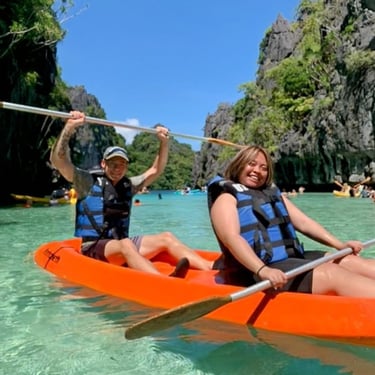
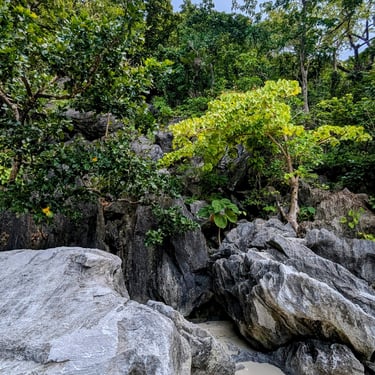
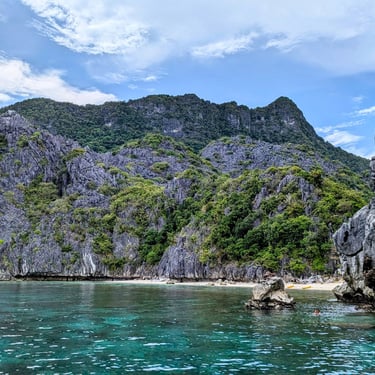
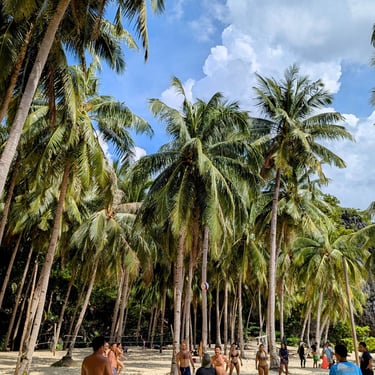
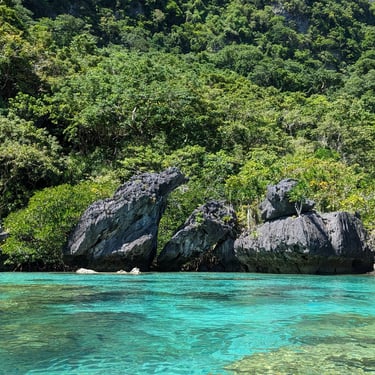
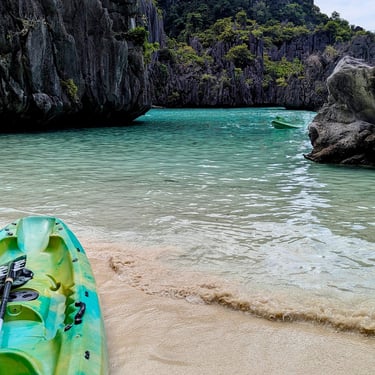
The second day in El Nido began, and today another tour with the same operator was on the agenda. This time, however, we didn’t have to pay the environmental fee, as the ticket from the previous day remains valid for 3–4 days after purchase. As usual, we gathered at the pavilion, checked in, and boarded the boat. Today’s destinations: Hidden Beach, Secret Lagoon, and Helicopter Island.
The engine roared to life, and we headed 30 minutes eastward through choppy waves. Upon arriving at Hidden Beach, which is indeed not easy to locate, I grabbed the snorkel gear I had added to my booking and explored the underwater world. I wholeheartedly recommend trying this—it was absolutely breathtaking! Schools of fish swam by, from eels to angelfish and other colorful species. The coral ecosystem was fascinating to observe… at least, what remains of it. Many corals are now damaged or dead, evident from the white remnants and the barren landscape. Nevertheless, the fish continued to thrive there. Many found homes in the coral caves, including moray eels and clownfish. I couldn’t help but wonder what this ecosystem must have looked like 30 years ago, before dynamite fishing and climate change had begun heating the oceans. Moments like these really made me realize how crucial it is to care for our planet and act responsibly. After all, what would happen to us if our habitat were destroyed?
But back to the story. I continued swimming along the reef until a call came from the distance, summoning me to the tour guide. There was something incredible to see: a giant Galapagos turtle. It circled the divers and me before disappearing into the ocean’s depths. I wished I could have captured this moment with a photo.
Once the turtle had vanished, we climbed back into the boat and set off for the next destination: Secret Lagoon. About 10 minutes from Hidden Beach, we arrived at a beach. As we set foot on the sand, I wondered where this secret lagoon might be. Then, from a distance, I spotted a small crevice in the rocks. To reach the other side, you had to crawl through it—and sure enough, a lagoon was hidden behind. To my amazement, even smaller fish lived there, likely due to the tides rising high enough for fish to pass through the rocky gap. After a brief visit, we swam back to the boat, sailed past Helicopter Island (though I still can’t say why it’s called that to this day…), and stopped there for a midday break to recharge.
With full stomachs and a quick snorkeling session, the day came to an end.
El Nido Tour 2
Hidden beach. Secret Lagoon. Helicopter Island.
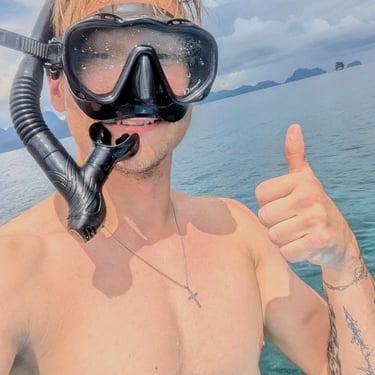
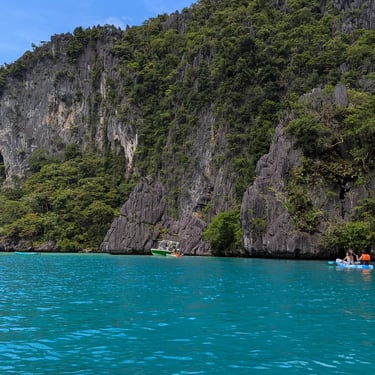
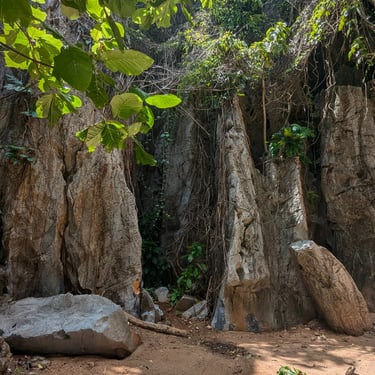

The last day on Palawan took us back to Puerto Princesa, where we planned to spend the evening winding down. While on the shuttle, I eagerly searched for activities to do in the area. That’s when I stumbled upon an unassuming yet fantastic tour: firefly watching. At first, it might sound boring—and believe me, I thought the same at first. But my opinion would change that very evening.
We were picked up by a van and driven to the harbor, where the guide was already waiting for us. After paying another environmental fee, we waited to board. In the meantime, the guide shared interesting facts about Palawan and the area we were in. For instance, he mentioned that Puerto Princesa had hosted the dragon boat world championships that year, which explained the many flags hanging everywhere. After a half-hour history lesson, it was finally time to board. We took our seats on the benches, and by now, it was pitch black outside. I couldn’t even tell exactly where we were headed.
About 20 minutes into the darkness, we arrived at a waterway that would lead us through the rainforest. From this point on, we were instructed to stay quiet and turn off any flashlights. As we eagerly awaited the fireflies, the guide shared fascinating facts about them.
Fireflies captivate us with their mysterious glow. But how is this even possible? Their light is produced through a chemical process called bioluminescence. This occurs when a substance called luciferin reacts with oxygen—completely without generating heat. The glowing plays a crucial role in mating: males and females communicate using unique blinking patterns that are specific to each species. Since fireflies live only a few weeks, they focus primarily on reproduction during this time rather than on feeding.
Another fascinating fact: fireflies are indicators of a healthy environment. They need clean habitats and are highly sensitive to pesticides.
Before long, I saw the first glow in the distance—it was simply a magical moment, as I had never seen fireflies before in my life. The branches and treetops pulsed with bright light, some glowing more intensely than others. Everywhere you looked, small lights flitted past our boat, moving from tree to tree. Of course, I couldn’t resist trying to capture this phenomenon on video, but as you might have guessed, a phone camera cannot come close to capturing as much light as the human eye. Even so, I’ve included a video for you, though it doesn’t remotely convey the wonder of what I experienced that night.
Firefly watching
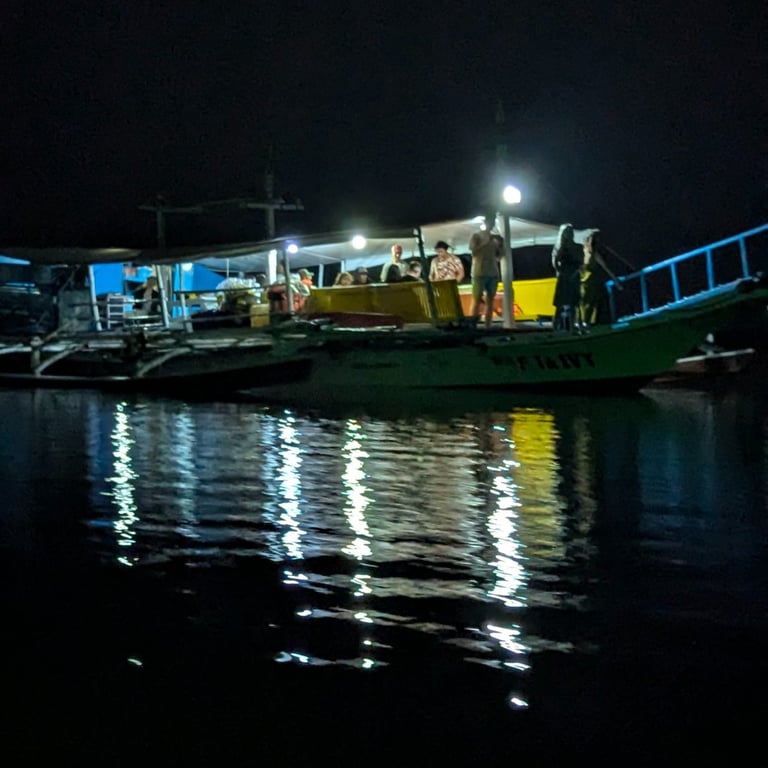
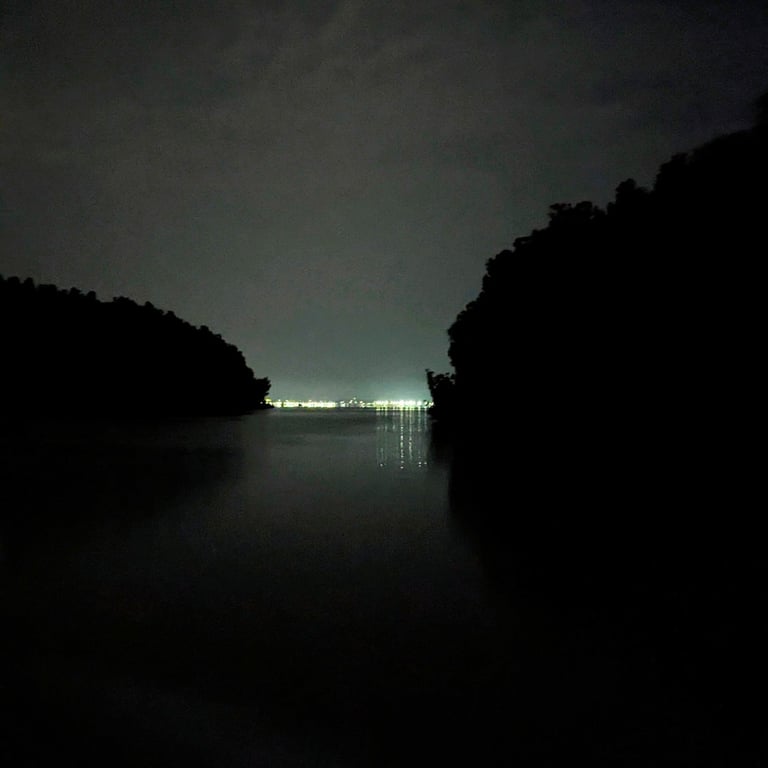
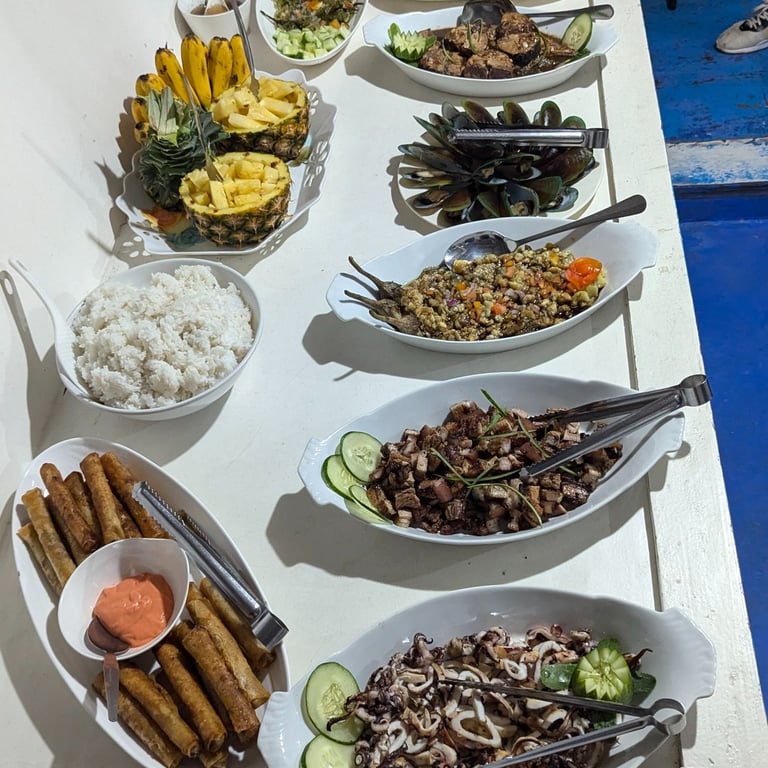

It was simply beautiful. So, if there’s one thing you should experience in life, it’s this!
After a good hour, we headed back to the open sea and stopped at a ship where we had dinner under the starry sky. With full stomachs and wonderful memories of the adventure, we were brought back to our Airbnb, where we prepared for the next day.
The alarm went off, I opened my eyes, and packed my suitcase—because today was the day we were leaving Palawan. We took a Grab to Puerto Princesa Airport to head to our next destination: Boracay. But why Boracay? The island is not only praised in the media but also came highly recommended by a friend living in the Philippines. It’s said to have the most beautiful sunsets in the world, a claim I was determined to investigate. After a long shuttle ride and a flight, we arrived at Godofredo P. Ramos Airport, which is not actually on Boracay but on the neighboring island of Panay.
At the airport, you can conveniently book a shuttle bus with a ferry transfer to Boracay. The cost is about €30. I opted for this, boarded the shuttle, and waited at the beach for the ferry. By now, night had fallen—it was mid-October, and the days were getting shorter. Soon, we were ushered onto the ferry, which took just 10 minutes to reach Boracay. From afar, I couldn’t see much land, only the many tiny lights of bars and beach houses decorating the island. Once ashore, a second shuttle brought us to Station 2, a centrally located district where most activities are easily accessible.
At the hotel, the hosts looked at us with puzzled expressions—it turned out I had booked the room for the next day by mistake. Luckily, this wasn’t a big problem as they still had a room available. We settled in briefly and then explored the nightlife.
Boracay is lively at night. There are many travelers from all over the world, along with numerous bars, restaurants, and souvenir shops. We opted for a Korean restaurant, as most Airbnbs lacked kitchens, making self-cooking impossible. The variety of Korean cuisine highlighted its uniqueness. For instance, they served dishes in stone bowls that continued sizzling for 30 minutes after being served. Many tables also featured flame grills where you could cook your own meat. I went with my usual choice—a bento box. The Korean version is quite similar to the Japanese one, offering customizable options based on your taste. Before heading back to our room, I took a walk on the beach with my girlfriend. It was pitch dark, but in the distance, you could make out the silhouettes of massive rocks and cliffs that defined the landscape. I could hardly wait to see Boracay in daylight.
The first quiet night was pleasant until I was awakened by singing from the neighbors. It seemed there was a reason to celebrate, as they had already cranked up their karaoke machine by 9 a.m. As you might know, Filipinos love karaoke. But what happened that day was the last thing I expected—more on that later.
After freshening up and putting on my swim trunks, we headed straight to the beach for the Boracay boat tour. The plan was the usual island hopping, with stops at the following places: Balinghai Beach, Coral Garden, Crocodile Island, Crystal Cove Resort, and Puka Beach. On the way to our first destination, the tour guide shared interesting insights about Boracay. The island is somewhat reminiscent of Siargao—both attract many tourists looking to party. In fact, Boracay is often compared to Mallorca. The island is divided into three stations, with Station 1 being home to the very wealthy. This was evident as we passed by luxurious villas and suites on our boat. But the highlight of the day was the Crystal Cove Resort.
Upon arriving at the island, we were given two hours to explore it without a guide. The island has three caves, which are its main attractions. I was particularly impressed by the well-maintained garden area. A lot of effort had gone into creating a resort with small gardens and walking trails. The views from the outer trails were breathtaking. I headed straight to the second cave, as most visitors flocked to the first one. After a ten-minute walk through a dense path, we reached the first cave. Along with a few others, I swam in the cave for a while before discovering a small passageway resembling a tunnel that supposedly led to the other side of the island. Crawling through it, I emerged in another cave. After a few minutes, I returned to the first cave. As I walked back along the long trail, I encountered other visitors, who were somewhat lost trying to find the second cave. At the first cave, I descended about 8 meters into a larger cavern than the first. But enough about the caves—for now. After the short stay on the island, we were called back to the boat. Unfortunately, we couldn’t visit the third cave due to the risk of collapse.
Our next stop was Balinghai Beach, where we took a break for lunch. As usual, the meal was included in the tour package and consisted of typical Filipino food. Afterward, we passed by Crocodile Island. The island is named not because of any crocodiles living there, but because its shape resembles one. Next, we stopped at Coral Garden, where we had the opportunity to snorkel. I couldn’t pass up the chance. As the name suggests, Coral Garden is home to a variety of coral species. Unfortunately, the area has been heavily affected by climate change: a vast, white wasteland with only a few intact corals covered the seabed. Nevertheless, it was fascinating to experience the underwater world with its many different fish species and sea urchins. After about 45 minutes, we moved on to our final stop: Puka Beach.
Puka Beach is a vast stretch of sand with little else besides sand and a few photo spots. To pass the time, I walked along the dunes and saw large, dark storm clouds in the distance, fortunately moving away from us. Further down the beach, I came across a photo spot that I had to capture. Two visitors approached me and asked me to take their picture in front of the artwork. Naturally, we took turns photographing each other and briefly exchanged stories about our experiences. Back at the boat, I encountered two boys playing baseball. They invited me to join, which I couldn’t refuse. During the game, they told me they lived in the dense forest of the island. At first, I couldn’t believe it, but upon closer inspection, I noticed some huts in the jungle. This way of life, deep in the wilderness, seemed foreign and likely more challenging than it appears. However, the boys were happy and excited to meet new visitors every day. As everyone gradually returned to their boats, I said goodbye to the boys.
Boracay Boat Tour
Puka Beach. Crystal Cove Island. Coral Garden. Crocodile Island.

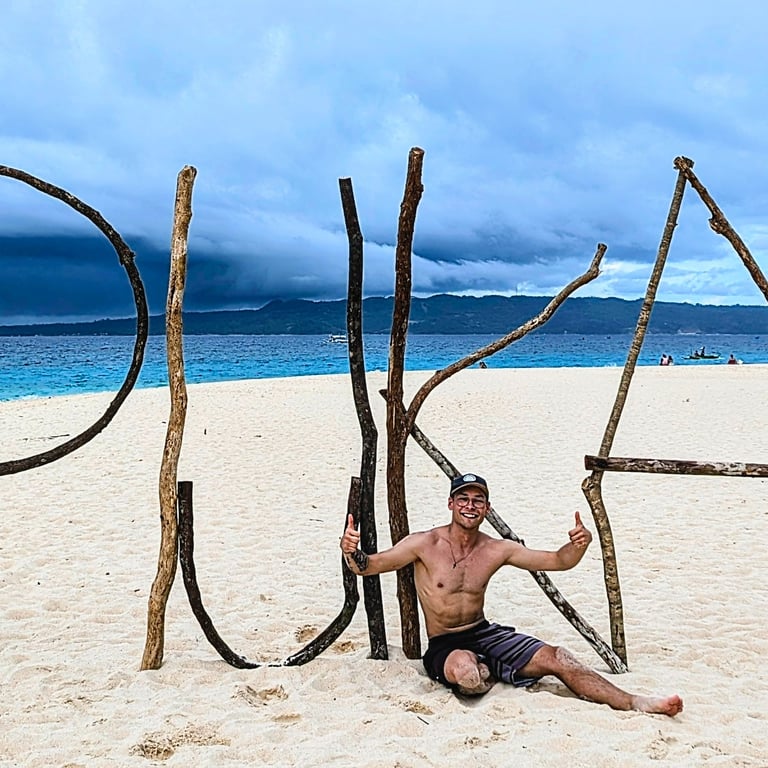
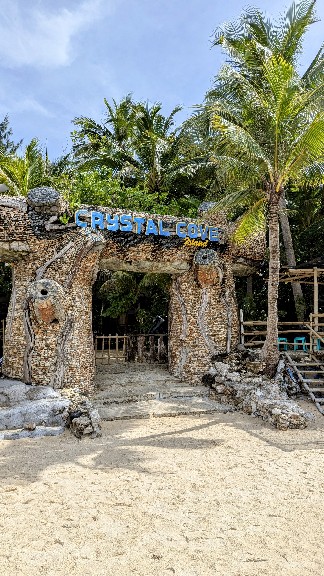
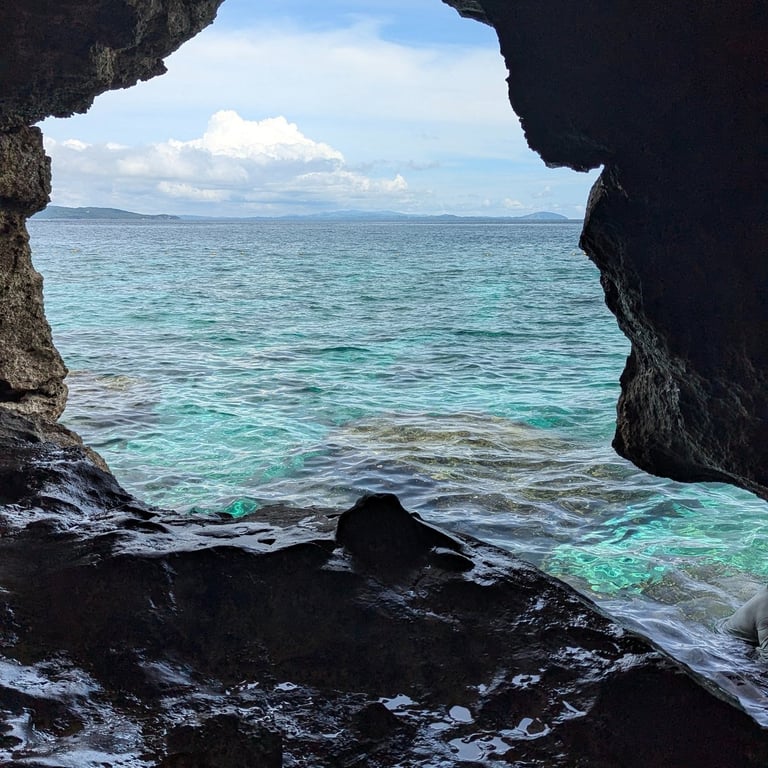
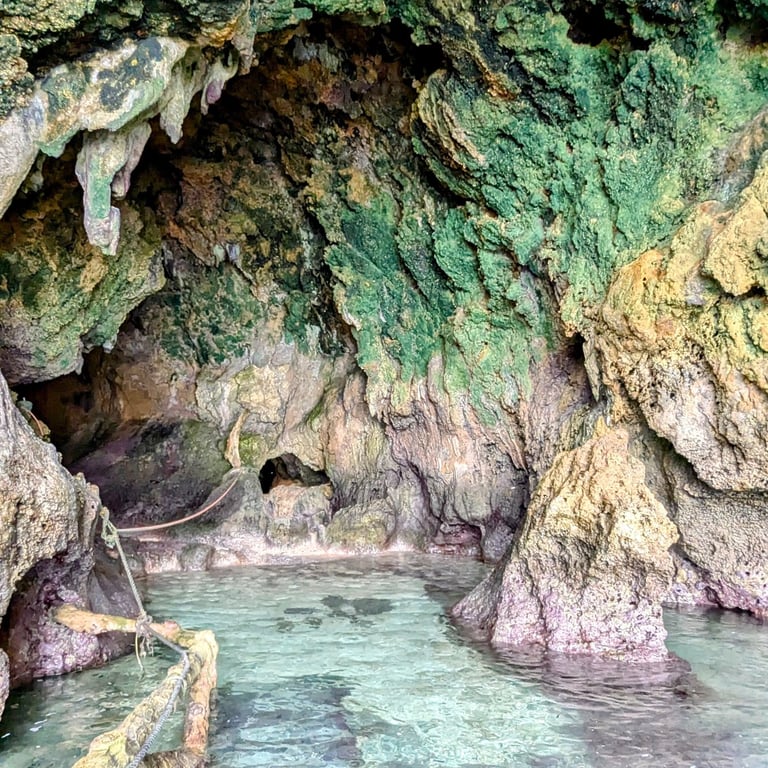

Back in Boracay, there was one more thing left on my bucket list: watching the sunset.
As soon as we arrived, we quickly went to the hotel to change. With my ukulele in hand, we headed to the beach. The sky was beginning to turn orange, and the sun’s rays shimmered beautifully on the water. Finding a suitable spot was tricky, as many people were already there. We settled under two palm trees, hoping no coconuts would fall on us. To pass the time, we chatted and sang songs together.
Finally, the moment arrived: the sun began to set. It’s no exaggeration when people say Boracay has the most beautiful sunsets in the world. The sight was magical. After a quick swim, I emerged from the water and continued playing my ukulele until a child sat down next to me. The boy had originally come to sell necklaces, but instead, he started having a heartfelt conversation with us.
His story was moving: he was 9 years old, had no permanent home, and usually slept on the beach with his brother. The necklaces he sold came from a supplier who paid him 10 pesos per necklace. Considering the price of food was around 500–1000 pesos, it was a tough life. Just before we were about to leave, he had a song request: "Another Love" by Tom Odell. We sang the song together, and I even taught him a little bit about playing the ukulele. It was a heartwarming moment.
Thus ended an eventful day—but not without my neighbors, who were still singing karaoke at 11 p.m. Apparently, karaoke is not just a hobby for Filipinos but a true passion. Two sleepless hours later, the music finally quieted down, and I was able to get some rest.
... later this evening.
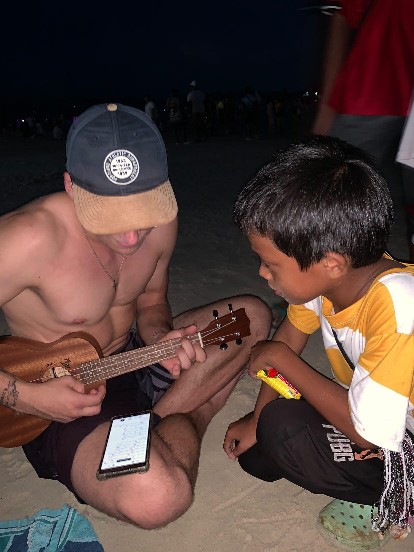
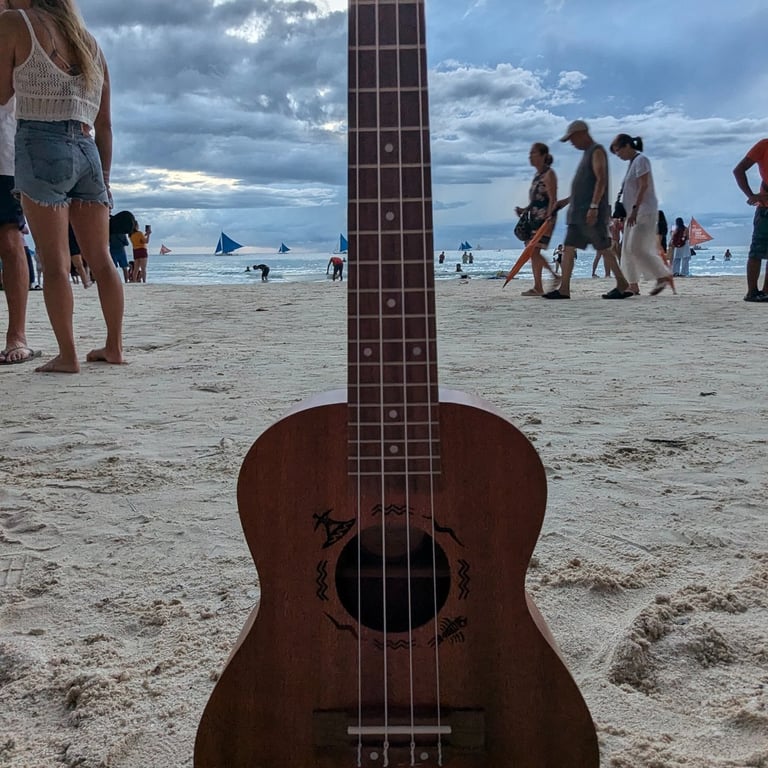
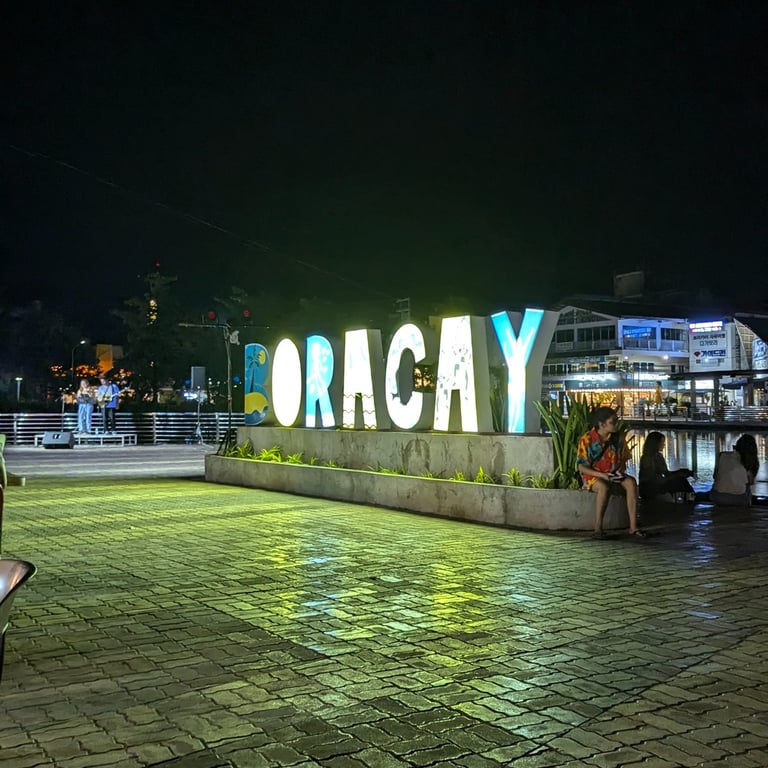
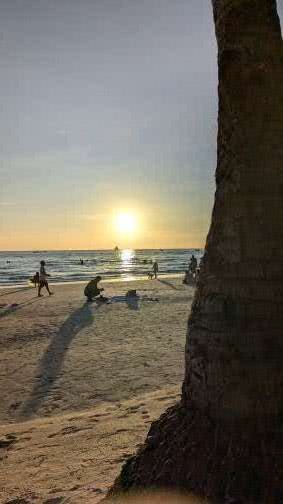
The next day, I was fortunately not woken up by karaoke but by the first rays of sunlight.
The day began with a visit to a treehouse café, where we worked on our school assignments while enjoying coconut coffee. Later, I was picked up for quad biking at Newcoast. After a brief introduction, we were off. Driving through the off-road terrain and stopping for photos was an exhilarating experience. In the evening, I wanted to admire the sunset again, but the sky remained overcast.
The third day brought a new adventure: parasailing. Although I’m not afraid of heights, parasailing seems much scarier in videos than it actually is. For those unfamiliar, parasailing involves sitting in a parachute that’s attached to a vehicle—usually a boat, as in my case.
Like the previous day, we returned to the familiar café to finish our schoolwork until it was time for me to head to the meeting point. Today’s experience cost me around €30. At the pavilion, I signed a quick waiver, and soon I was on a speedboat headed toward a mothership. There, as expected, we received a short safety briefing before another motorboat picked me up. We cruised out to open waters, where the captain instructed me to step onto the launch platform at the stern. Once the harnesses were secured, it began: the boat sped up, the parachute filled with air, and I felt my feet leave the ground.
In seconds, I was soaring above the water, climbing higher and higher. At first, the sensation was thrilling—like riding a roller coaster. But once I reached the top, about 20 meters above sea level, the excitement gave way to pure awe. From up there, I had a breathtaking view of Boracay, Station 2, and Newcoast. It was a fascinating experience that I can wholeheartedly recommend to anyone.
To conclude our stay, we booked a sunset boat cruise, which turned out to be the highlight of our time on Boracay. Originally, we had opted for a basic boat tour, but we were unexpectedly upgraded to a yacht experience at no extra cost. The cruise offered free-flowing alcohol, lively music, and even a diving board for swimming.
During the trip, I met several interesting people, including Kevin from Ireland, who later joined me at a bar for a game of beer pong to cap off the evening. The bar was run by a German expat who shared his life story. It was fascinating to hear how he had found happiness on Boracay.
My last days in Boracay
Parasailing. Riding a quad. Bars. Food.
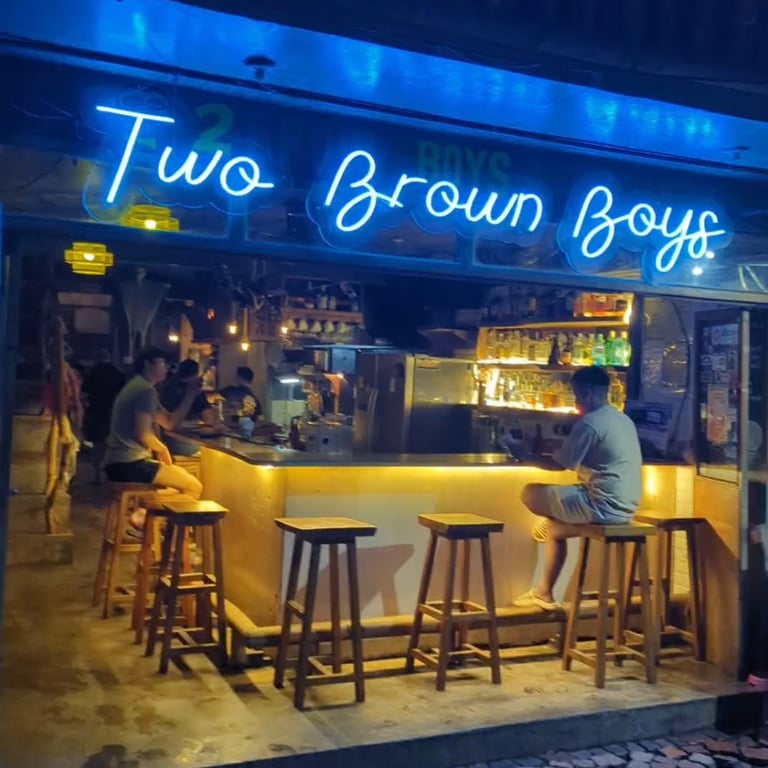
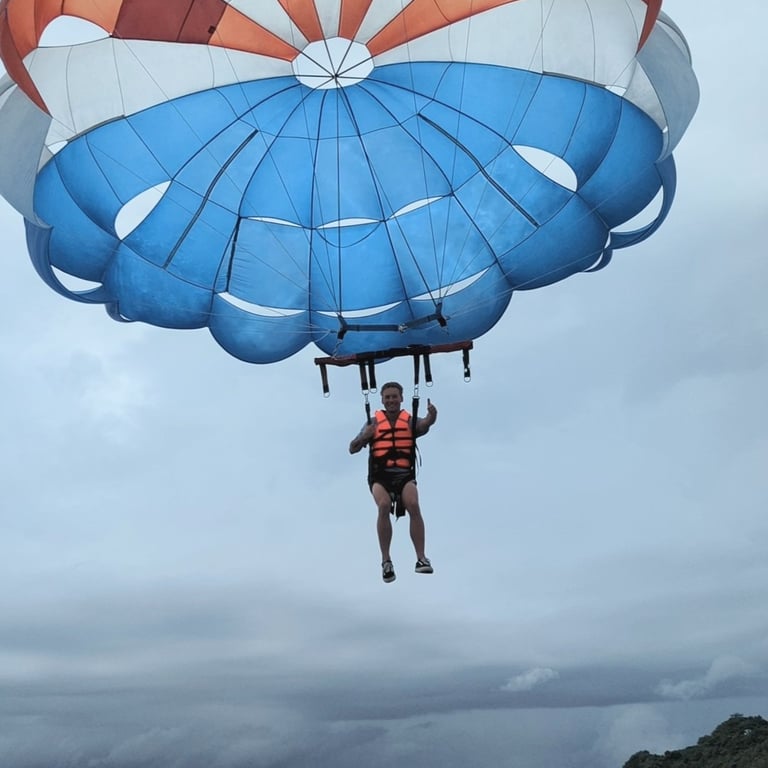
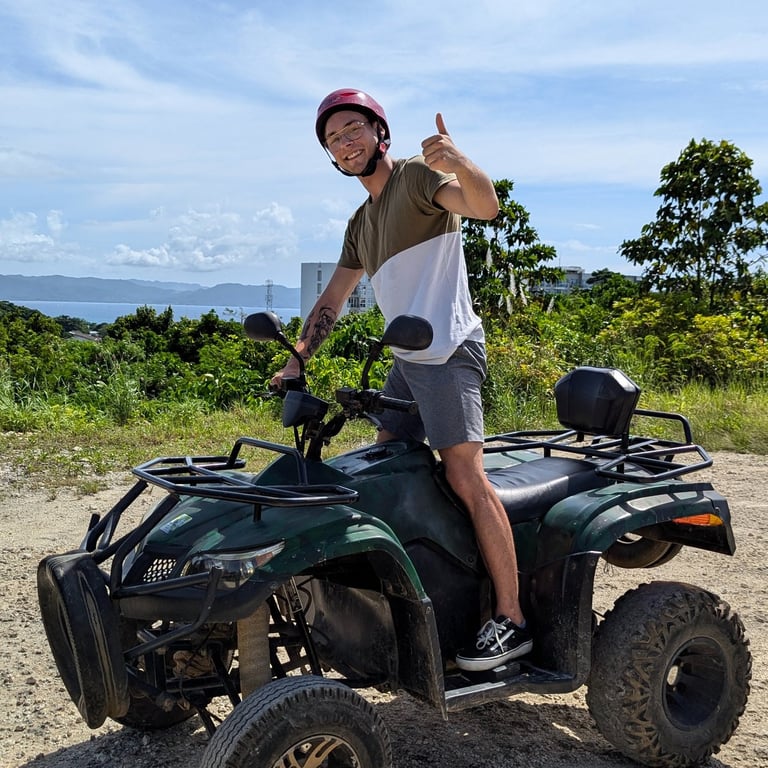
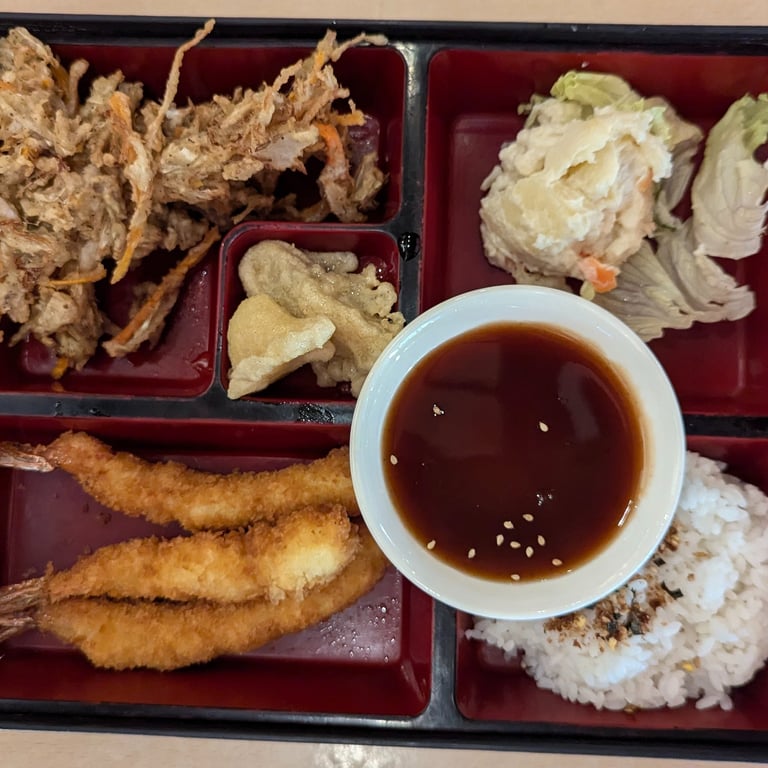

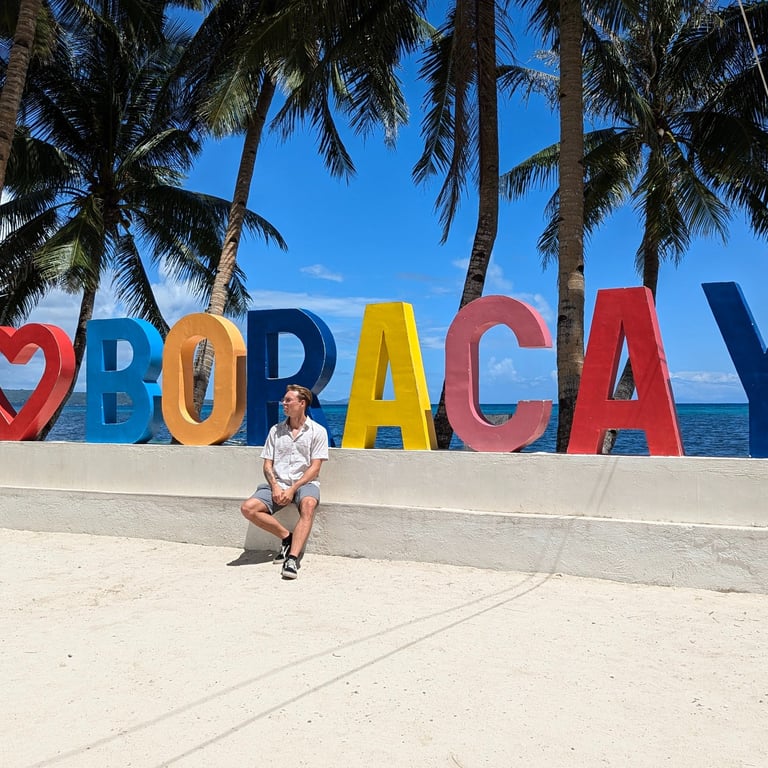
Boracay left a lasting impression on me with its experiences and encounters. From breathtaking sunsets to heartwarming moments, it was an unforgettable journey.
Early in the morning, still hungover, I quickly packed my belongings, and together we headed to the harbor, where I said goodbye to my girlfriend. Today, my journey was to continue—to the next island: Romblon.
But why Romblon, of all places? It’s not marketed anywhere online as a tourist destination. The reason was simple: I wanted to visit a friend who had moved there. I wanted to talk to him about his experiences in the Philippines and understand whether relocating there had been worthwhile for him.
Unfortunately, things didn’t go as planned. Even on the early morning trip to the harbor, the ocean was turbulent, and the wind was howling fiercely. At the harbor, I first had to book a boat ride. However, the staff at the ticket counter informed me that I would need to wait as they were unsure how the weather would develop.
In the meantime, I headed across the street to a 7-Eleven and bought breakfast. Two hours later, the news came: all boat trips would be canceled for the coming weeks due to a typhoon. “Great,” I thought to myself and quickly booked a flight back to Manila to avoid being stranded on this island. Luckily, the flight went smoothly, and I didn’t have to stay stuck there.
I spent my final days, much like the beginning of my trip, in Santa Rosa due to the typhoon. Not only was the weather a disaster, but my health also took a hit. Over the days, I became ill and couldn’t do much, leaving little to report about my last week—apart from a few highlights. For instance, I was unexpectedly invited to a wedding and spent my penultimate day at the birthday party of my newfound friends.
These beautiful moments showed me how much Filipinos value friendship and family. All of us should take time in our lives to be grateful for the things we have—whether material possessions or relationships with the people around us. We need to be more mindful of this and remind ourselves that nothing should be taken for granted.
The present-focused lifestyle of many Filipinos is also remarkable. For them, it’s the here and now, friends, and family that matter most. Perhaps you’ve taken something from this post for yourself or are now planning your own trip to the Philippines.
Thank you for taking the time to read my blog post to the end. I hope you enjoyed it.
